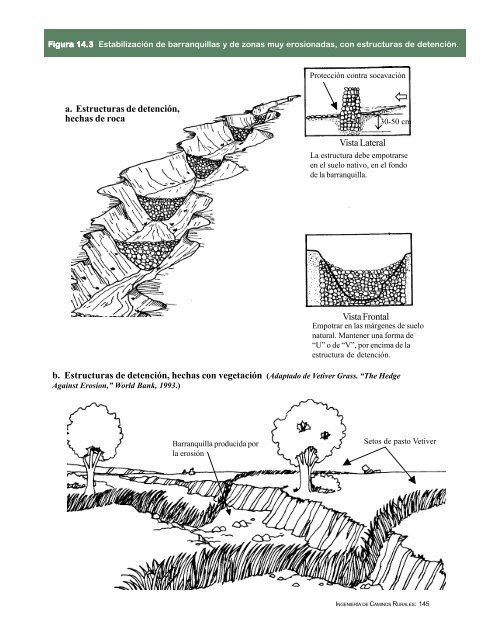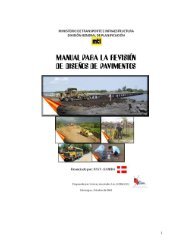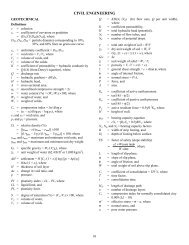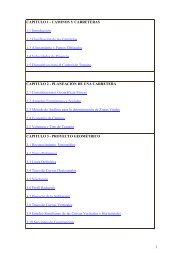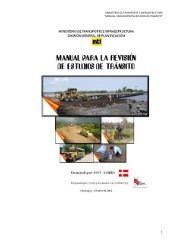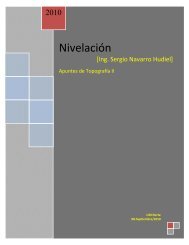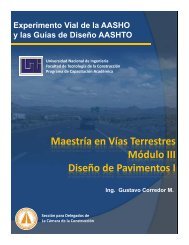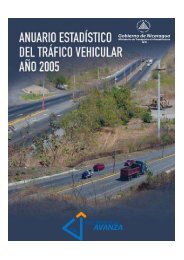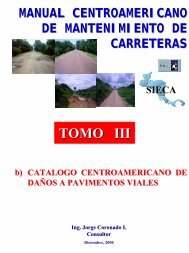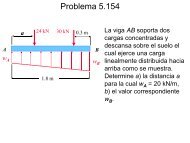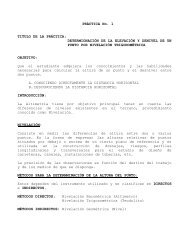- Page 1:
INGENIERÍA DECAMINOS RURALESGuía
- Page 5:
correcta consideración del drenaje
- Page 8 and 9:
INGENIERÍA DE CAMINOS RURALESGuía
- Page 10 and 11:
Definición de TérminosOrdenados p
- Page 12 and 13:
inestable.Corte en balcón y transp
- Page 14 and 15:
tratamientos superficiales bitumino
- Page 16 and 17:
generalmente el lado del talud del
- Page 18 and 19:
Muro de cabeza o de remate (Headwal
- Page 20 and 21:
Figura (VI.1): Empleo de Vegetació
- Page 22 and 23:
Sedimentación (Sedimento) [Sedimen
- Page 24 and 25:
Capítulo 1 IntroducciónCapítulo
- Page 26 and 27:
MEJORES PRÁCTICAS DEADMINISTRACIÓ
- Page 28 and 29:
Capítulo 2Análisis Ambiental¡Inv
- Page 30 and 31:
PRÁCTICASRECOMENDADAS• Usar el p
- Page 32 and 33:
para generar mejores diseños decam
- Page 34 and 35:
Capítulo 3Aspectos de Planeacióny
- Page 36 and 37:
Foto 3.1 Camino local con bajo volu
- Page 38 and 39:
a los caminos ¡antes de que ocurra
- Page 40 and 41:
Figurigura 3.4 Anchos de la Zona Pr
- Page 42 and 43:
Foto 3.7 Ubique los caminos de arra
- Page 44 and 45:
Capítulo 4Ingeniería de Caminos R
- Page 46 and 47:
inaceptables.Planeación de caminos
- Page 48 and 49:
PRÁCTICAS RECOMENDADASDiseño gene
- Page 50 and 51:
Tabla 4.1NORMAS TÍPICAS DE DISEÑO
- Page 52 and 53:
PRÁCTICAS QUEDEBEN EVITARSEFigura
- Page 54 and 55:
Mantenimiento• Llevar a cabo el m
- Page 56 and 57:
para devolverle su condición natur
- Page 58 and 59:
PRÁCTICAS RECOMENDADASCierre del c
- Page 60 and 61:
Capítulo 5Hidrología para a elDis
- Page 62 and 63:
LA FÓRMULA RACIONALPara determinar
- Page 64 and 65:
Figura 5.2 Curvas típicas de frecu
- Page 66 and 67:
Capítulo 6Herramientas para a Dise
- Page 68 and 69:
Foto 6.2 Enrocamiento usado para la
- Page 70 and 71:
protección (Diámetro) necesario p
- Page 72 and 73:
Figura 6.2Dos ejemplos de protecci
- Page 74 and 75:
Figura 6.3 Aplicaciones típicas de
- Page 76 and 77:
LA UBICACIÓN DEL CAMINO y el drena
- Page 78 and 79:
Tabla 7.1Distancias máximas recome
- Page 80 and 81:
PRÁCTICAS QUE DEBEN EVITARSE• Pe
- Page 82 and 83:
○ ○ ○ ○ ○ ○ ○ ○ ○
- Page 84 and 85:
alcantarillas generalmente se coloc
- Page 86 and 87:
Figura 7.7 Detalle de la protecció
- Page 88 and 89:
incluye por lo general tubos dealca
- Page 90 and 91:
Figurigura 7.10 Cruces de drenaje n
- Page 92 and 93:
Figura 7.11 (continuación)Buena pr
- Page 94 and 95:
necesita un refuerzo considerable d
- Page 96 and 97:
Figurigura 7.15 Vado de postes o de
- Page 98 and 99:
Capítulo 8Uso, , Instalación yDim
- Page 100 and 101:
“material granular seleccionado
- Page 102 and 103:
Figura 8.2 Alineación de la alcant
- Page 104 and 105:
Figurigura 8.4 Protección a la ent
- Page 106 and 107:
Figurigura 8.6 Opciones de rejilla
- Page 108 and 109:
Figura 8.7b Altura del agua río ar
- Page 110 and 111:
PRÁCTICAS RECOMENDADASAlcantarilla
- Page 112 and 113:
PRÁCTICAS QUE DEBEN EVITARSE• De
- Page 114 and 115:
LOS CRUCES EN ESTIAJE, vados como s
- Page 116 and 117:
confinamiento; protección del bord
- Page 118 and 119: PRÁCTICAS RECOMENDADAS• Usar una
- Page 120 and 121: Capítulo 10Puentes“Puentes -- ge
- Page 122 and 123: Foto 10.2 La estructura de un puent
- Page 124 and 125: Figurigura 10.2 Instalación de un
- Page 126 and 127: Capítulo 11Estabilización de Talu
- Page 128 and 129: elleno (Foto 11.4). Un relleno dero
- Page 130 and 131: Figura 11.2 Opciones de diseño par
- Page 132 and 133: Foto 11.6 Compactación simple a ma
- Page 134 and 135: Figura 11.4 Continuación. (Adaptad
- Page 136 and 137: • Usar construcción balanceada d
- Page 138 and 139: Capítulo 12Materiales para a Camin
- Page 140 and 141: • Agregar material de mayorresist
- Page 142 and 143: Figura 12.3 Estados físicos de mez
- Page 144 and 145: No. 200, con tamaño de 0,074 mmde
- Page 146 and 147: Foto 12.6 Uso de un “ densímetro
- Page 148 and 149: Foto 12.9 Explote pedreras ybancos
- Page 150 and 151: Figurigura 12.5 Buenas y malas prá
- Page 152 and 153: Capítulo 13Control ol de la Erosi
- Page 154 and 155: Tabla 13.1Elementos Clave de un Pla
- Page 156 and 157: Photo 13.4 Zona de trabajoalterada
- Page 158 and 159: Figura 13.2a Estructuras para el co
- Page 160 and 161: CaminoSembradíosFigura 13.3 Estruc
- Page 162 and 163: PRÁCTICAS RECOMENDADAS• Desarrol
- Page 164 and 165: LASBARRANQUILLAS CONSTITUYEN una fo
- Page 166 and 167: canal y el subsecuente avance hacia
- Page 170 and 171: Refefererencias encias Seleccionada
- Page 172 and 173: Keller, G.; Sherar, J. 2000. Practi
- Page 174 and 175: Forest Service. 222 pp. [Online] ht
- Page 176 and 177: Cedergren, H. 1977. Seepage, draina
- Page 178 and 179: PUENTESAmerican Association of Stat
- Page 180 and 181: para el Programa de Espesor de la S


